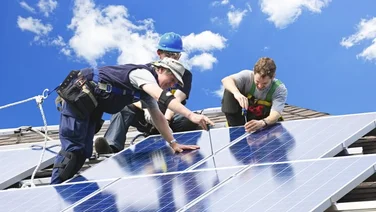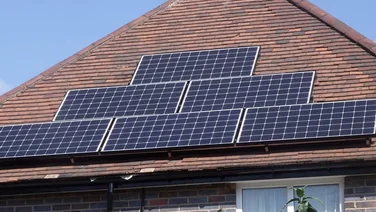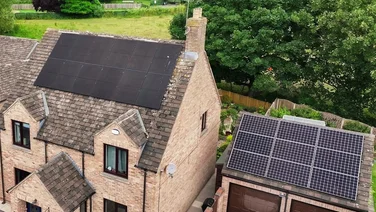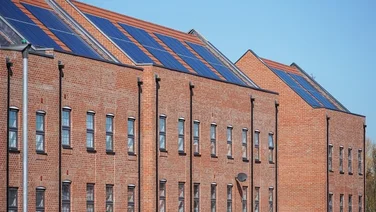✔ Solar panels work by converting sunlight into electricity
✔ All solar panels are made using photovoltaic materials
✔ It takes seconds for solar panels to start generating electricity from sunlight
Solar panels convert sunlight into electricity that can power your home, city, and country – but before you pay solar panel prices for this ingenious piece of green technology, you’ll want to know how it accomplishes its scientific feat.
In this guide, we’ll walk you through how your solar panels generate energy, and the different factors that can help and hinder this process.
To start collecting free quotes for solar panels, fill in this quick form, and our suppliers will be in touch.
Where do you want to install solar panels?
Get started
How do solar panels work, step by step?
Solar panels turn light into electricity by using photovoltaic technology.
You can reduce the number of solar panel costs you have to deal with over the years by getting a qualified professional to install them. Here’s how it happens, step by step.
Step 1: Sunlight hits the panel
The sun emits light, otherwise known as solar radiation, which shines onto your solar panel.
Step 2: An electrical current is born
Each solar cell on your panel has two layers. Both are made of silicon, but one has some added phosphorus, while the other has some added boron.
When the photons in sunlight hit a solar cell, they shake the electrons in the phosphorus layer loose, and they travel to the layer containing boron.
This creates an electrical charge – but you can’t use it to power your appliances just yet.
Read about how solar panels are made here.
Step 3: DC to AC
Your solar inverter will turn this electrical charge from DC into AC, making it usable in your home.
The solar inverter, which usually costs between £500 and £1,000, is crucial to making your solar panels function.
Step 4: Enjoy your renewable source of energy
The solar panel system will then send this AC electricity into your home, where you can use it to power your life and reduce your energy bills.
If you want to work out how many and what peak power output you’d like your panels to have, use our solar panel output calculator.
How long does it take for solar panels to generate electricity?
Solar panels generate electricity within seconds of sunlight hitting them.
The entire process is so quick that you won’t notice it happening.
Once the sun starts to rise on your panels and there’s enough ambient light in the sky, your system will kick into gear and you’ll be able to access solar power straight away.
Where do you want to install solar panels?
Get startedDo solar panels need direct sunlight?
Solar panels don’t need to be in direct sunlight to produce electricity.
They’re certainly most efficient when they receive direct sunlight, but they still produce electricity when it’s cloudy or if part of your array is in shade.
On average, light cloud cover will lead to a power output loss of 23.8%, while heavy cloud cover will reduce your output by 66.8%, according to the latest scientific research.
If you can’t do anything about some of your panels being in shade for parts of the day, you can use microinverters or power optimisers to ensure your other panels aren’t affected.
Your array doesn’t need direct sunlight to do its job, but it should still get some to work most effectively – so make sure you ask installers whether your area receives enough direct sunlight to make solar panels worth it.
Do solar panels work at night?
Solar panels don’t work at night, unfortunately.
As the sun gradually goes down, your panels will keep functioning until there isn’t enough ambient light for them to absorb – and then they’ll rest until the sun rises.
If you want to keep using solar energy at night – and make the most of your panels – check out our guide to solar batteries.
A solar battery can retain all the energy you don’t use throughout the day, so you can keep using this free power source after the sun goes down.
The alternative is selling this excess energy back to one of the dozen or so suppliers that provide a Smart Export Guarantee tariff.

The best conditions for solar panels to work
You can’t control the weather, but there are four key things you can do to ensure you get the best out of your solar panels.
1. Point them south
The direction your solar panels face is the most important factor when setting up a solar PV system.
If part of your roof faces the south or even southwest or southeast, this is where you should point your panels. Since the sun rises in the east and sets in the west, south-facing panels have the best chance of capturing the most sunlight across the day.
2. Angle them at 30°
You want the sunlight to be hitting your panels as directly as possible. In the UK, this means a 30-45° angle is ideal.
As the sun changes its position in the sky throughout the year, the optimum angle for your solar panels will change. In the winter, they should be positioned at a steep 60°, while in the height of summer, a low 20° is best.
However, once your panels have been installed, it’s not easy to readjust the angle every few months (unless you hire a professional installer to do it for you).
That’s why 30° is the recommended permanent position for your panels.
Want to learn more? Head to our page: What’s The Best Angle and Direction for Solar Panels?
3. Remove the shade
There’s no point in getting the perfect direction and angle for your solar PV system if it’s just going to sit in shade.
Be sure to clear away anything that might cast a shadow on your panels, particularly any big trees. If the obstruction is in your neighbour’s garden, ask them nicely or reconsider your panels’ positions.
4. Keep them clean
As dust and dirt build up on your panels, they’ll gradually become less effective. The sunlight will find it harder to reach the solar cells under the grime, and you’ll have less electricity to use at home.
It’s therefore best to keep your solar panels clean. Manufacturers recommend you give your panels a clean once or twice a year, and you can either do this yourself, or pay around £100 for a professional to do it for you.
Of course, rainfall in the UK helps to keep solar panels pretty clean, but there’s only so much lichen, plant sap, and bird droppings that rain can handle.
Next steps
If you think a switch to solar sounds like the right move for you and your household, you’ve picked a great time to do it.
69% of people are likely to buy a house with solar panels, according to our latest National Home Energy Survey.
And we can help you make the switch. Just fill in this short form, and our professional installers will be in touch with their quotes.
FAQs
How to solar panels work step by step?
Photons from the sun hit the photovoltaic solar cells, which energises the cells and makes electrons come loose from atoms within a semiconductor wafer. The electrons are then pushed into motion by an electric field surrounding the semiconductor wafer, which creates an electrical current. This current then powers your home, after it’s converted from AC to DC.
Do you pay for electricity after installing solar panels?
Solar panels will save the average three-bedroom household roughly £454 on their energy bills a year. You will still have to pay for some electricity because your solar panels system won’t work at night.
You could get a storage battery to help with this, but it’s not financially beneficial. This is because you’ll need to purchase two batteries within the lifespan of your solar panel system which means the break-even point for solar-plus-storage is around 27 years.
The key benefit of adding a storage battery to your solar panel system is the ability to use 80% or so of the electricity your panel generate, rather than the usual 50%.
Do I need to tell my energy supplier if I get solar panels?
You must contact your Distribution Network Operator (DNO) if you install solar panels or any other generation equipment and feed electricity back to the grid. This is because they’ll need to know you’re feeding back to the grid (via the Smart Export Guarantee for example) so they can manage their networks properly.







